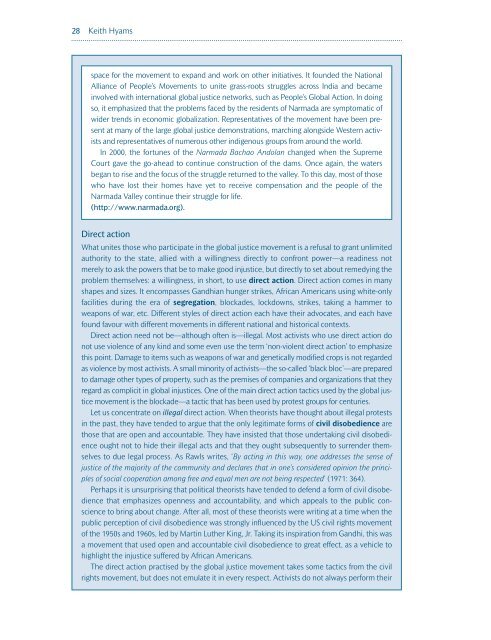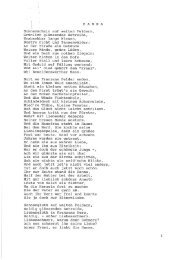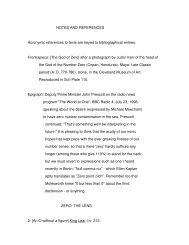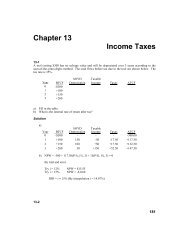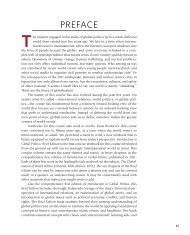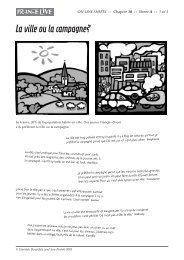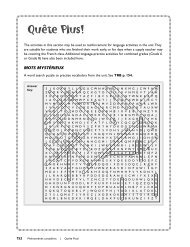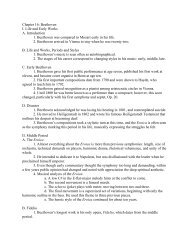1 Political authority and obligation Political authority and obligation
1 Political authority and obligation Political authority and obligation
1 Political authority and obligation Political authority and obligation
You also want an ePaper? Increase the reach of your titles
YUMPU automatically turns print PDFs into web optimized ePapers that Google loves.
28 Keith Hyams<br />
space for the movement to exp<strong>and</strong> <strong>and</strong> work on other initiatives. It founded the National<br />
Alliance of People’s Movements to unite grass-roots struggles across India <strong>and</strong> became<br />
involved with international global justice networks, such as People’s Global Action. In doing<br />
so, it emphasized that the problems faced by the residents of Narmada are symptomatic of<br />
wider trends in economic globalization. Representatives of the movement have been present<br />
at many of the large global justice demonstrations, marching alongside Western activists<br />
<strong>and</strong> representatives of numerous other indigenous groups from around the world.<br />
In 2000, the fortunes of the Narmada Bachao Andolan changed when the Supreme<br />
Court gave the go-ahead to continue construction of the dams. Once again, the waters<br />
began to rise <strong>and</strong> the focus of the struggle returned to the valley. To this day, most of those<br />
who have lost their homes have yet to receive compensation <strong>and</strong> the people of the<br />
Narmada Valley continue their struggle for life.<br />
(http://www.narmada.org).<br />
Direct action<br />
What unites those who participate in the global justice movement is a refusal to grant unlimited<br />
<strong>authority</strong> to the state, allied with a willingness directly to confront power—a readiness not<br />
merely to ask the powers that be to make good injustice, but directly to set about remedying the<br />
problem themselves: a willingness, in short, to use direct action. Direct action comes in many<br />
shapes <strong>and</strong> sizes. It encompasses G<strong>and</strong>hian hunger strikes, African Americans using white-only<br />
facilities during the era of segregation, blockades, lockdowns, strikes, taking a hammer to<br />
weapons of war, etc. Different styles of direct action each have their advocates, <strong>and</strong> each have<br />
found favour with different movements in different national <strong>and</strong> historical contexts.<br />
Direct action need not be—although often is—illegal. Most activists who use direct action do<br />
not use violence of any kind <strong>and</strong> some even use the term ‘non-violent direct action’ to emphasize<br />
this point. Damage to items such as weapons of war <strong>and</strong> genetically modified crops is not regarded<br />
as violence by most activists. A small minority of activists—the so-called ‘black bloc’—are prepared<br />
to damage other types of property, such as the premises of companies <strong>and</strong> organizations that they<br />
regard as complicit in global injustices. One of the main direct action tactics used by the global justice<br />
movement is the blockade—a tactic that has been used by protest groups for centuries.<br />
Let us concentrate on illegal direct action. When theorists have thought about illegal protests<br />
in the past, they have tended to argue that the only legitimate forms of civil disobedience are<br />
those that are open <strong>and</strong> accountable. They have insisted that those undertaking civil disobedience<br />
ought not to hide their illegal acts <strong>and</strong> that they ought subsequently to surrender themselves<br />
to due legal process. As Rawls writes, ‘By acting in this way, one addresses the sense of<br />
justice of the majority of the community <strong>and</strong> declares that in one’s considered opinion the principles<br />
of social cooperation among free <strong>and</strong> equal men are not being respected’ (1971: 364).<br />
Perhaps it is unsurprising that political theorists have tended to defend a form of civil disobedience<br />
that emphasizes openness <strong>and</strong> accountability, <strong>and</strong> which appeals to the public conscience<br />
to bring about change. After all, most of these theorists were writing at a time when the<br />
public perception of civil disobedience was strongly influenced by the US civil rights movement<br />
of the 1950s <strong>and</strong> 1960s, led by Martin Luther King, Jr. Taking its inspiration from G<strong>and</strong>hi, this was<br />
a movement that used open <strong>and</strong> accountable civil disobedience to great effect, as a vehicle to<br />
highlight the injustice suffered by African Americans.<br />
The direct action practised by the global justice movement takes some tactics from the civil<br />
rights movement, but does not emulate it in every respect. Activists do not always perform their


